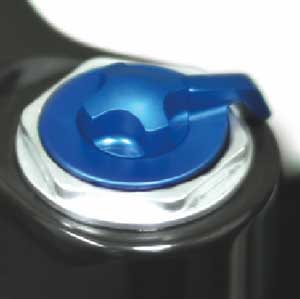FOX Racing Shox : 2007 freeride and downhill

2007 is less a year of revolution and more a year of refinement. Here are the highlights.
– Better bottom-out resistance for 36 and 40
– Easier travel adjustment for 36
– 10 mm more travel for 36
– Improved rear shock mounting bushings
– New graphics all around
36 Forks

|
The mighty and versatile 36 is still available in three models: FLOAT air sprung, VAN coil sprung and TALAS air sprung/travel-adjustable.
What’s new
TALAS II. The TALAS system on last year’s 36 let the rider adjust between 100 and 150mm of travel, with each click of the blue wheel changing the travel by 3 mm. To go all the way from full-up to full-down required plenty of turning and clicking.FOX learned that most riders ran their 36s all the way up or all the way down, or maybe somewhere in the middle. But no one was thinking “12 clicks in for this climb, six clicks in for this singletrack” and writing the numbers on their stems.
So FOX simplified the travel adjustment. Instead of the click-wheel of fortune, TALAS II uses a little blue lever. In 90 degrees of sweep you get three distinct settings: 100mm, 130mm and 160mm. That should speed the transitions between climbing and ripping.
Bottom-out control. If there was any critique of 2006 36s and 40s: They were hungry for full travel. They’d just gobble it up every time they got a chance. Near the end of their travel a small piston would ride into a cylinder, which theoretically increased oil pressure and controlled bottom-outs. But the fit between the piston and cylinder was too loose, and those high oil pressures never happened. Weak sauce.

|
The new bottom-out control rocks the strong sauce. First, the cylinder is cone-shaped. Second, the piston has an “interference fit,” which means it actually touches the inside of the cone. Third, the cone has four sets of holes along its height. When the piston first hits the cone, oil flows through all four ports. Then it squeezes oil through three ports, then two, then just one. The oil pressure builds up gradually, and it builds big.
The old bottom setup generated 80 pounds of bottom-out resistance. The new one generates 600 pounds. HUGE DIFFERENCE! The resistance starts around 1 1/4 inches from the bottom of the stroke and builds smoothly from there. And one more adjustment: The little piston can be moved up or down to engage the cone sooner or later.
Travel increase. From 150 to 160mm (5.9 to 6.3 inches). The axle-to-crown height is 10mm higher.
New graphics. Sweet style.
What’s still cool
FIT cartridge with oil bladder to keep oil and air separate. This prevents cavitation, foaming and loss of damping control. In English: You get consistent damping even across myriad hits.
RC2 damper with separate low- and high-speed compression adjustment. Use the low speed to give your bike the feel you want. Super plush, firm or whatever. Use the high speed to handle the kind of hits you encounter on your rides; this is an easy way to adjust for different trails and different levels of aggression. Thanks to the new bottom-out control, you can run the high speed looser and still avoid the dreaded CLANK!
40 Forks

|
FOX’s light, supple downhill fork remains unchanged for 2007 except:
Bottom-out control. Same as the 36. It engages in the last 1.5 – 2 inches of travel, and the contact point is adjustable. This will improve the 40 for big-hit riding.
New graphics. Sick!
Rear Shocks
Nothing super new here. Just updated graphics that ‘capture the spirit” of the shocks. But these shocks are crazy-tunable and crazy-capable, so here’s a refresher course:
DHX
In the aftermarket FOX never know which bike the shock will go on, and it’s impossible to predict the terrain and riding style of each rider. The more advanced riders get, the more they notice small changes in shock performance, and the more they demand a certain feel.
To that end, DHX air and coil shocks provide these adjustments:
Rebound control. A speed-sensitive shim stack releases the shock slowly after a large, slow hit but lets out rebound quickly after successive, fast hits. This automatically compensates between, say, pumping for a jump and hitting a log at speed.
Air pressure valve to adjust bottom out range as well as ProPedal range. While the reservoir pressure and ProPedal are related, they can be adjusted separately. With 140psi in the reservoir you get up to about 45 pounds of ProPedal resistance. At 200psi, you get up to 70 pounds of ProPedal.

|
Bottom out resistance via a hex-keyed dial. This changes the reservoir volume and adjusts the shock’s progressiveness. Bigger air volume = more linear. Smaller air volume = more progressive.
Since this dial changes the end spring rate but leaves the beginning of the stroke alone, it’s a great way to adjust for different conditions. For example, last year my DHX 5.0 was set up for racing downhill in the Rocky Mountains — fast and bumpy but not super gnarly. When I went to Whistler, I started bottoming like a champ – CLANK CLANK CLANK! I turned the dial in a few turns. The bike still felt basically the same, but the final ramp kept metal from hitting metal. Ha, metal. Rock and roll!
ProPedal Damping via a 15-click knob. This position-sensitive adjuster controls the initial shock stroke.
While it’s not externally adjustable, the compression shim stack is designed to swallow harsh impacts (high speed damping) while preventing diving and wallowing (low speed damping).
DHX AIR and DHX COIL shocks are essentially identical except for the springs. The 5.0 models offer every adjustment and are available OEM and aftermarket. The 4.0 model is OE only, and it lacks the adjustable bottom-out resistance. The 3.0 is also OE only, and it skips the bottom-out resistance and ProPedal adjustment. These ‘limited” versions are probably fine for most riders — all those 5.0 settings can make you crazy.
VAN R
The VAN R costs less and offers fewer tuning options, but it has the same chassis as the DHX. The VAN R provides the essential adjustments: external spring preload and external rebound. Compression damping and ProPedal are set at the factory. Braaap!
New mounting bushings on all shocks! Let’s not forget these little guys. The new, tighter-tolerance bushings last twice as long as the old ones, at least in FOX stress tests. Here’s to finding out for ourselves!

Comments are closed.